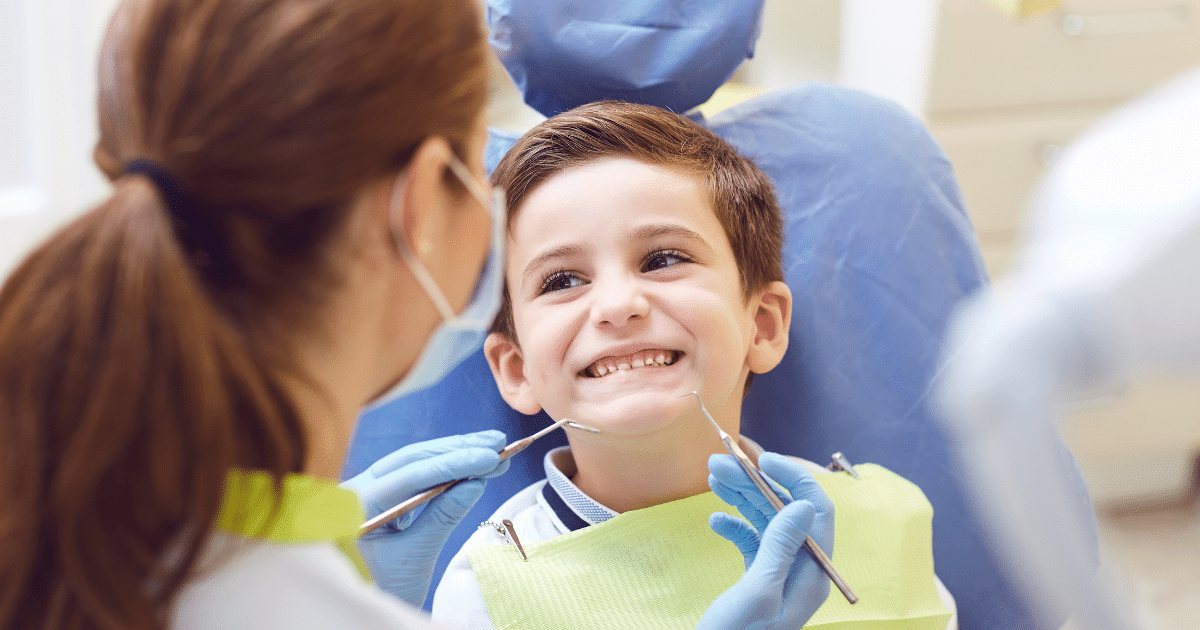
Contents:
Straightening teeth during childhood improves the appearance and functionality of the mouth, enhancing overall oral health and self-esteem. For this reason, the consideration of teeth straightening for kids is a must.
If you are concerned about your child's teeth alignment, you're going to want to know everything there is to know about getting their pearly whites in a row.
This has been written by a mum who has straightened her two children's teeth - one with traditional braces, the other with Invisalign. It delves into the why, when, and how of teeth straightening for kids. It sheds light on the importance of early intervention, suitable treatment timings, and available straightening methods to achieve a perfect smile that your little one can be proud of.
Why should I get my child's teeth straightened
Boost their self-confidence
It's easy to presume that any set of teeth, crooked or straight, small or big, as long as they're white and clean, should be good enough. But there is more to teeth than just digestive function.
Most culture's aesthetic standards, including ours, consider straight teeth as ideal and attractive. It gives the impression that one is well-groomed and has good genetics. Who doesn't want that?
As your kids enter puberty, their desire to fit in, look good, and feel accepted becomes an increased priority. The confidence they have is heavily influenced by how they perceive their own appearance.
According to NatruSmile, 25% to 50% of children require orthodontic treatment at some point.
Giving your child the opportunity to improve their smile and correct malocclusion-related speech defects will boost their self-confidence and reassure them if they have any hang-ups about their teeth alignment.
Improve oral health
Well-aligned teeth helps your child avoid risks of build up and hidden cavities that happens in overcrowding. Straighter teeth are easier to brush and floss. Receiving teeth straightening treatment will help your kids find it more convenient to take care of their teeth.
Sometimes, with crooked teeth, some teeth may go through overwear due to compensatory biting and chewing habits that your kids develop because of how their teeth are positioned. This could lead to cavities or erosion of the enamel.
Further reading: 6 Terrifying facts to scare your kids into brushing their teeth.
Correct bite issues
Bite is one of the main things that orthodontists pay attention to and treat when they provide teeth straightening.
There are more important (but underlying) issues than appearance when it comes to a 'bad bite'.
Whether your child has an overbite or an underbite, or even a seemingly normal bite with misaligned teeth, malocclusion affects not only their facial shape but also what happens in their whole mouth and jaw.
A bad bite can cause jaw disorders, gum injuries, tongue infection, and tooth decay in the long run. Having straight teeth and a strong bite will make chewing, speaking, cleaning (and even sleeping and closing the mouth!) easy for your child.
Better chewing
As I've mentioned about having a strong bite in the previous paragraph, straighter teeth make eating and chewing a non-chore for your kid's oral anatomy.
I can still remember when my kids had crooked teeth; they would often accidentally bite and nick their tongue while chewing. If they were eating something hard or crispy, they might prefer to chew in a specific side of their mouth because they felt like their teeth there were just 'better' at chewing. As a mum, I was worried that their teeth were making it uncomfortable for them to do the basic task of eating. So to the orthodontist, we went.
Enhanced speech
Quirky and cute as they are, lisps and whistles are not fun when you are a kid growing up among peers at school. We know how these can be something they get teased for, which may make them feel insecure. Not to mention that these are speech defects in of themselves.
Malocclusion can cause unusual speech habits and patterns in your kids because of the way they learn how to form sounds as comfortably as possible with the imperfect oral anatomy that they have. Huge gaps, protruding teeth, crowding, and a bad bite are all contributory factors that influence the way your child talks.
It's a great thing that you can restore their confidence and comfort at speaking by providing them the chance to straighten their teeth.
Prevent dental injuries/issues in the future
Our mouths open and close countless times in a day when we are speaking and eating. The weight or force of our jaws coming together should ideally be distributed equally among all our teeth.
With malocclusion or crooked teeth, some of our teeth may bear more of the impact due to their protrusion or crowding. This means that it's only a matter of time before their enamel gets fractured or wears away, leading to cavities and other dental injuries. Getting your kids' teeth straightened reduce these risks hugely.
When should I start the teeth straightening treatment?
Now you may think, "Okay, I would love to get my kids' teeth straightened, but should I do it now, or can it wait?". Well, the answer is yes and yes.
There is really no age limit when it comes to teeth straightening. Some parents put their children through braces as early as 6 years. Some adults get it themselves as late as 35.
However, most orthodontists agree that it is best to start treatment when most of the permanent teeth have come in. Orthodontists consider ages 12-14 as the best time to start teeth straightening because the child has most of their adult teeth and their jaw structure is most conducive to treatment.
Dental changes do not happen at the exact pace for all kids. The right timing for braces will be best advised by your child's dentist.
How to choose a good orthodontist?
Getting teeth straightening treatment for your child can be a little bit intimidating, especially if you have never gotten it yourself and it is your first time to look for an orthodontist. And as always, we want the best for our children. I understand, this simple hunt can feel like a lot of pressure.
Don't worry, I've got tips for you that I hope will reassure and help you.
Personal recommendations
You can start off by looking at the local orthodontist listings in your neighbourhood or city. It's good to rely on a clinic that is within minutes from your home and your kids' school so regular visits can be easily done in between errands and on your kids' schedules.
There is also nothing wrong with setting appointments with different orthodontists. Schedule initial consultation with them to compare their rates and opinion and to observe their communication styles and facilities. This can help you narrow down your choices, too, if you've got a list of orthodontists whom you are considering.
If looking for the right one becomes overwhelming, do it the old fashioned way: Ask your family and friends for recommendations. Usually, someone in your circle already had a satisfactory experience with teeth straightening, and they can refer you to the right orthodontist.
Areas of expertise
Note that several orthodontists have specialised practice. Look for someone who works with a lot of children and who has an extensive practice in treating malocclusion.
Yes, you may feel tempted to go for an orthodontist who is widely experienced in straightening teeth for patients of all ages (they're all just teeth, right?) because they surely know what they are doing. Sure, there is nothing wrong with going in that direction. But consider your kid's experience, too.
You would want an experienced healthcare provider who is also known for their effective communication and rapport with kids. This gives your kid a better chance at feeling comfortable and reassured during every orthodontist appointment. Don't forget, your kids have to deal with them for months, or even a couple of years.
Cost and payment options
Giving your child the gift of straighter teeth should not cost you an arm and a leg. Check if your health insurance policy covers orthodontist treatment. If it does not, know that you don't have to necessarily burn through your pockets in order to get your kid good teeth straightening treatment.
When compared, traditional braces are more cost-effective than invisible aligners. Both have their pros and cons and these are things you should also consider.
Note that clinics and orthodontists offer different rates. If you have a set budget, I suggest that you stick with it and give it a small but reasonable wiggle room when comparing your choices of orthodontists.
A lot of practices understandably recommend a one-time but discounted payment. But if that is too heavy for you (hey, inflation is tough on all of us), several practices are able to offer credit card and installment options. With traditional braces especially, payment schedule can be staggered to a regular series of installments that coincide with every brace adjustment visit.
Treatment approach and technology
You should also consider the practice of an orthodontist and the technology they use. This is why looking up your potential orthodontist online can be helpful.
Clinic websites can inform you of how the treatment process is done by the orthodontist. They may even share on their website or social media pages how they approach specific cases of malocclusion and how they usually prefer to treat their patients.
If they are using advanced technology and the latest equipment, they will be proud to mention it. Employing innovation and better technology will help an orthodontist perform safer and less painful treatments on their patients.
Online reviews
A lot of times, to see is to believe.
When you're online sleuthing on potential orthodontists, check practitioners in your area who regularly post images of their work on their website and social media accounts. Doing this can help you compare their patients' before and after teeth straightening results and read reviews from their clients.
Reviews can reveal more than just how perfect an orthodontist can make your teeth look. Other clients can tell you a lot about the work ethic of the orthodontist and their clinic staff, their values, the physical condition of their facilities, and if they charge too much.
What are my teeth straightening options?
When it comes to dental braces and and retainers, you've got two main options when it comes to teeth straightening that are widely available. These are traditional braces and invisible aligners, or more commonly known as Invisalign.
Traditional braces to straighten teeth
Traditional braces are usually made of metal and attached to the outer part of the teeth. Now, aside from metal, there are different options for traditional braces, including ceramic attachments and lingual braces (when braces are attached behind the teeth). Metal wires and rubber bands are part of the braces and are adjusted regularly to manipulate and gradually move the teeth to their ideal position, correcting orthodontic problems.
Aside from its cost-effectiveness, traditional braces' strong advantage is that they are reputed to correct multiple dental and facial issues during a patient's course of treatment. Traditional braces are suitable for a wide range of malocclusion cases, no matter how difficult or complex. Because this method literally uses metal anchors and wires, it employs more force and reliable mechanism in pulling the teeth into the 'perfect' position.
There are also options to choose from when it comes to 'customising' traditional braces to straighten the teeth. For an additional cost, you can consider ceramic braces. These use ceramic bracket attachments that are colourless or the same colour as your kid's teeth (instead of the regular gray metallic ones) so that only the wires are *barely* visible. You can also opt for lingual braces for your kids, where the brackets are attached behind their teeth, effectively hiding the braces when they smile.
There are downsides to traditional braces that may or may not affect your decision. Braces are very visible, especially the regular metal ones. If your kid is self-conscious, you might want to consider other options.
Traditional braces can also be quite uncomfortable and injure the inside of your child's lips and cheeks, especially within the first couple of months of them being installed. This can take a lot of getting used to depending on your kid's tolerance for discomfort. And while this can be easily addressed with salt wash and brace wax, it can still be annoying.
There will also be some restrictions when it comes to food. Gum, corn on the cob, apples, thick chewy or crispy food like fried pork skin... Think of anything that makes a loud and hard crunch or requires biting through. These foods can detach one or more brackets while your child bites and chews through them, making the braces ineffective until your child has to go back to the orthodontist for bracket reattachment and adjustment.
Speaking of adjustment, regular visits for braces adjustment will be required. Appointments should be set every 3-4 weeks with the clinic, or as recommended by the orthodontist, so that they can ensure that your kid's teeth are moving in the right direction. This can be inconvenient, especially if you are a busy parent.
Lastly, brushing and flossing can feel like a chore with traditional braces. Because braces are permanently attached on your child's teeth (which could be an advantage depending on how you look at it), using tiny brushes for the brackets and superfloss so they can carefully floss through the wires will be an added part to your kid's oral hygiene routine. While some may find this therapeutic, it can certainly eat up more time. And that's not fun for any kid who wants to do anything but clean their teeth.
Invisalign to straighten teeth
Invisalign treatment makes use of colorless and clear plastic aligners. These aligners are fitted and customised for each patient through 3D scan technology applied on the patient's mouth. Customised aligners, updated and replaced every few weeks or months, are then made and fit to move the teeth gradually until their ideal position is achieved.
The primary advantage and selling point of Invisalign to straighten the teeth is that it's practically invisible. Because of its clear quality, unless someone looks very hard, Invisalign is barely noticeable especially in photos. This is a great option for your self-conscious teen.
Invisalign also requires less adjustment appointments with the orthodontist. Unlike having traditional braces, wearing aligners rely a lot on the 3D scan technology which in turn determines the timing of aligner re-adjustments and the position of the teeth. This means you don't have to worry about taking a lot of time off work and having to constantly remind your child about their upcoming appointment.
Because they are also customised for your kid's oral structure, it is more comfortable to wear and there are less risks for gum and cheek problems. Cuts and abrasions inside the mouth won't be a problem, unlike in traditional braces.
Your kid will also have an easy time cleaning their teeth because of how convenient it is to remove the aligners before brushing and flossing.
These are amazing advantages, right? But not all that glitters is gold. Or maybe in this case, it is. One of the biggest disadvantages of Invisalign is its cost. Because of the technology and flexible material used, it is more expensive to opt for Invisalign than traditional braces.
And considering that you are getting teeth straightening treatment for your kid, I am not sure how much trust you can put in your darling child when it comes to expecting them to faithfully return their Invisalign to their mouth after every time they eat, drink, brush, and floss. Because Invisalign is conveniently removable, many a times do adults lose or misplace them; how much more a kid?
Another con is because your kid's teeth are wearing these aligners, food and bacteria may be trapped inside for hours at a time which can increase your kid's risk for cavities.
Lastly, Invisalign does not guarantee perfect results just by itself. In more complex cases of malocclusion, it's not uncommon for orthodontists to recommend transitioning to traditional braces for the last stretch of the treatment in order to achieve perfect results. So be prepared for that possibility too if you choose Invisalign.













